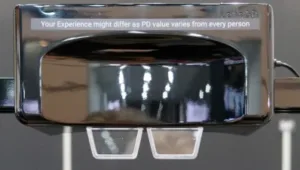We reported briefly on LetinAR from CES, but we caught up with them only at the very end of the show and had no time to discuss with them. There was a little more time at MWC.
The company has an AR optical combiner that it calls ‘pin-mirror’. The system uses a number of tiny curved mirrors embedded in the lens of an AR headset or set of smartglasses. The mirror is a good option as it doesn’t have issues of focus, and the mirror is designed so that the images from the individual mirrors merge to create an apparently seamless wider image and with a wide field of view. The field of view of the mirrors, horizontally and vertically is determined by the number and configuration of the mirrors, with a single mirror supporting 15º (note our original report said 40, but this was an error. The 40º is a hoped for future level) FOV. The lenses can be made in glass or plastic and can be up to 5 dioptre strength.
 LetinAR’s Headset demo shows the mirror configuration. Click for a close up image. Image:Meko
LetinAR’s Headset demo shows the mirror configuration. Click for a close up image. Image:Meko
The main demo used a 720P OLED microdisplay and the company was showing two rows of mirrors (8 + 7) which the company plans to expand to three rows in the future to support up to 45º FOV vertically.
 LetinAR’s mirrors allow a wide FOV. It’s hard to get a good image. Image:Meko
LetinAR’s mirrors allow a wide FOV. It’s hard to get a good image. Image:Meko
At the show, the company was demonstrating a new and higher resolution than it had at CES and with 2560 x 720 resolution (there were dual 2560 x 1440 displays for each eye). There were some artefacts between the pin mirror images that were more obvious than on the lower resolution demo, but it seems that the firm has not been able to get the displays that it would like to use, so each eye was using a combination of the output of the two different LCDs.
Analyst Comment
This company’s technology is intriguing. The optical performance is very good and the system is very simple. However, there are, we think, two ‘gotchas’.
First, the lenses really need to be used with the image source from the top, because this is the widest part of the display. From a physics point of view, the optics would work with the image coming from the side, but it would be hard to support a wide horizontal field of view, which is one of the key advantages, as the mirrors need to be ‘interlaced’ in the different rows. AR glasses are better when the imager can be on the sides.
The second issue is cost. The real cost of the system is in the very expensive tooling needed to create the lenses. In large volumes, the cost becomes small as most of the cost is a fixed charge in the non-recurring tooling. However, without high volume, the cost becomes very high as the cost has to be spread over a low volume. (BR)
 LetinAR supports a wide range of options in lenses and configurations. Image:Meko
LetinAR supports a wide range of options in lenses and configurations. Image:Meko

